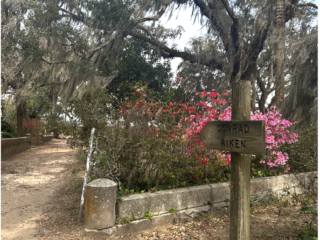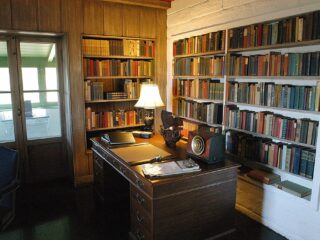by Linda McGovern
If you didn’t know Kate Chopin had lived there for a time, you might never have heard of or driven through Cloutierville with a second glance. Located along the Cane River in Natchitoches Parish in Northwest Louisiana, Cloutierville (pronounced Cloochyville) is approximately 260 miles from New Orleans. Kate Chopin described Cloutierville in one of her stories as, “This little French village was simply two long rows of very old frame houses, facing each other closely across a dusty roadway.” 1 The quiet town hasn’t changed much since Chopin’s day and it still stands as a town set in the past, charmingly out of place in the modern day.
Cloutierville was founded in 1822 by a Frenchman named Alexis Cloutier who hoped to make it the center of a new parish (county) but instead it remained very small. As I looked down the same small, once dusty but now paved, road there was no one to be seen, not even a designated parking place for visitors, just the grass by the side of the road.
Kate Chopin and her husband Oscar lived in this house for approximately four years. They moved from New Orleans in 1878, when Oscar’s business as a cotton factor failed, due to the fact that his cotton yields were so small. He suffered terrible financial losses, which seemed to follow him for the remainder of his life.
Oscar bought a comfortable two story home in Cloutierville. He borrowed money to buy a general store, which sold just about everything one could need. Although it became very popular with the other residents, it is uncertain how lucrative it was considering he was too lenient in giving credit.
Kate Chopin became a distinct presence in the town. She was popular with the other townspeople but nonetheless remained an enigma, even to this day. Some of Oscar’s relatives lived in the town, so Kate apparently assimilated quickly and felt part of Cloutierville, “Her home became the center of social life. Her inherited esprit or gaiety made her the delight of her social equals – affectionately admired and approved her tact {and} her musical and conversational talents.” 2 However, besides her engaging qualities, some locals did not understand her and thought her husband gave her too much independence and sovereignty over her own behavior and whims. Kate was notorious for her unconventional manner of dress, especially in her horseback riding apparel, described as a ” a fantastic affair a close fitting habit of blue cloth, the train fastened up at the side to disclose an embroidered skirt, and the little feet encased in pretty boots with high heels. A jaunty little jockey hat and feather, and buff gloves rendered her charming. ” 3 She was both cosmopolitan in her appearance as well as with her wit and intelligence. Her big presence in a small town was not always compatible.
Oscar, a rather delicate man, died suddenly from Swamp Fever in 1882 leaving Kate, a young widow at the age of thirty one years old, to raise their six children alone. There have been speculations as to why she never remarried, possibly for the independence and control she gained of herself and her body, another is that she loved Oscar too much, or her writing became her new love and interest.
Kate Chopin was infamous, as our guide confirmed, for having an affair with a local resident, Albert Sampite, apparently after Oscar died. It seems to have been well known throughout the town. ” The general talk was that he was in love with the pretty widow, and there were those who believed that she, too, was in love with him.” 4 Supposedly Kate was the reason for Albert’s failed marriage. Although Kate is known for writing about unfulfilled women, especially housewives, who need and struggle for freedom and truth, it appears Kate loved Oscar very much and he gave her the freedom and independence she craved. But because of the nature of her stories, which paint a rather different portrait of her, one wonders if Kate Chopin had another side to her, one that was less than content.
The curator of the Chopin home, Amanda Chenault, showed me around on a very hot August day. Needless to say, there was no air conditioning inside. The home is white with green trim. There are large first and second story porches on the home. The Chopin family lived on the second floor where the breezes were stronger. There is a Bayou Folk Museum on the first floor that entails remnants and memorabilia of former Cloutierville residents with a brief history of the town. Many of the artifacts show their faces through a glass casing.
It was very warm as the tour began and I found myself the only visitor that day. Overall, the home gave the appearance of being quite large. The structure of the home, the floors and walls were in their original state, but almost all of the furniture were period pieces and not the property of the Chopin family. The rooms were rather close together and I pictured the six Chopin children playing and romping around indoors on a rainy day. How chaotic it must have been trying to keep them all entertained.
Graciously, Amanda gave me ample time to view the home and its premises. The stairs pointing to the spacious attic were a long ascent upward and the heat was practically unbearable. The screen porch at the rear of the house was my favorite room in the home; it was so quaint and I could imagine Kate sitting there relaxing while she took a few moments for herself in solitude. There is an aura of family happiness in the home. It seems she was happy in the years she lived in Cloutierville. Although, I would speculate Kate probably would have been happy and creative anywhere.
After Oscar died, Kate was able to carry on with the business successfully for more than a year and pay off most of his debts. Kate left Cloutierville and finally gave into the insistence of her mother who wanted Kate and the family to return to St. Louis. She may have wanted to put the scandal between her and Albert behind her and move on. Unfortunately, her mother died shortly afterward, a year or so following Kate’s arrival. Kate experienced much grief from the deaths of her loved ones over her lifetime. Because of her strength and the support of family and friends, she was able to thrive as a woman, mother, and most of all a great writer. What is so interesting is that many of her stories are written about Louisiana and Natchitoches Parish and only a handful about St. Louis. However, they were not written while she lived in Cloutierville, but in St. Louis. Her heart still seemed irrevocably connected to Louisiana. There was something important to her in her time spent there. She was persuaded to write by a long time friend, Dr. Kolbenheyer, and perhaps because of financial as well as artistic need. Kate published her first poem in 1889 after which her writing career blossomed.
In 1904, Kate Chopin died of a brain hemorrhage at the age of fifty three. At this time, her writing career was considered scandalous and her writings were banished because of her subject matter. Kate Chopin died never knowing the praise she was to receive. She lived and died before her time. It was not until many years passed that interest in her work was revived and the spirit of her writing fully recognized for its true worth.
Kate Chopin certainly left her mark on Cloutierville as well as the rest of the world. The Chopin Home and Bayou Folk Museum are well worth a visit where for a few moments you can forget time and perhaps catch a glimpse of her walking, as she often did, through the town on the dusty road leaving her footprints behind for those willing to see them.









2 comments
Sadly, the museum burned to the ground in October of 2008.